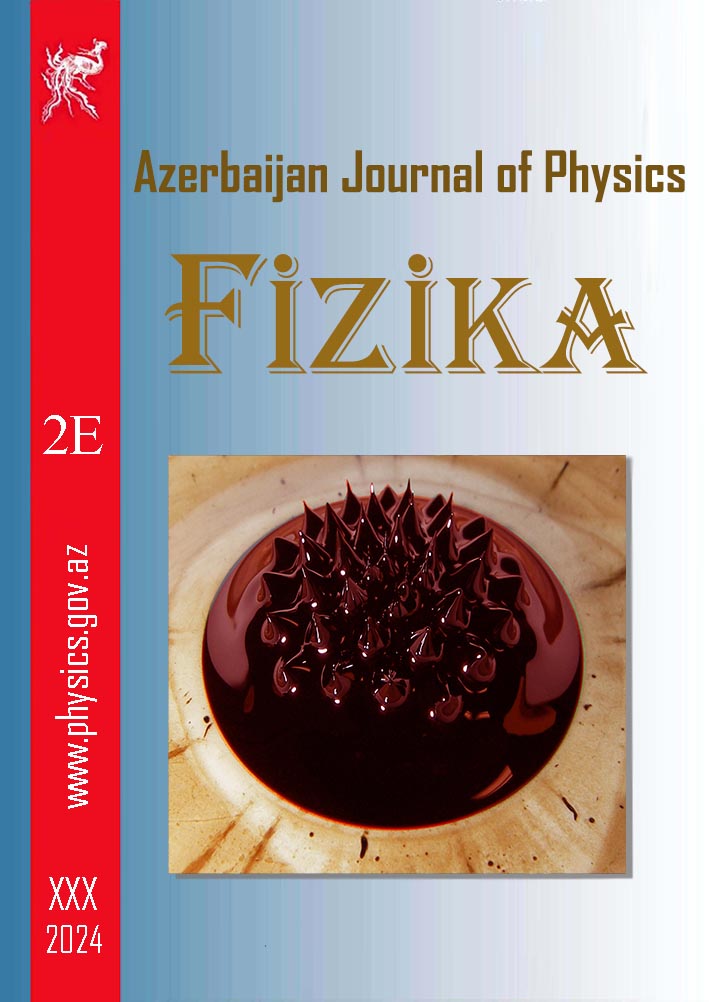ABSTRACT
In the near-surface area of Bi2Se3 crystals, in order to reduce concentration of charge carriers and Se vacancies, which are electronic donors,
annealing in selenium vapor was used. It has been established that the most optimal mode is annealing at a temperature of 100-150 °C for 70 hours. Effective impact on the
surface condition with an identical purpose is exerted by processing the sample in a glow discharge in an argon medium. It was determined that treatment with an ions dose
of ~1,1·1017 ion/cm-2, both after and without preliminary treatments in the form of annealing or chemical etching, leads to a significant decrease in concentration of
carriers in crystals near-surface area.
Keywords: concentration of carriers, Se vacancies, annealing, selenium vapor, discharge, argon medium, treatment, ions dose, chemical etching.
PACS: 78.20.Jq, 78.68.+m,
Received: 16.02.2021
AUTHORS & AFFILIATIONS
1. Institute of Physics of ANAS, AZ1143, H.Javid ave., 131, Baku, Azerbaijan
2. Baku State University, AZ1148, Z. Khalilov str., 23, Baku, Azerbaijan
E-mail: samir.gahramanov@gmail.com
|
REFERENCIES
[1] L. Fu, C.L. Kane, E.J. Mele. Topological insulators in three dimensions.Phys. Rev. Lett., 2007, vol. 98, 106803, doi.org/10.1103/
[2] H. Zhang, C.X. Liu, X.L. Qi, X. Dai, Z. Fang, S.C. Zhang. Topological insulators in Bi2Se3, Bi2Te3 and Sb2Se3 with a single Dirac cone on the surface. Nature Phys., 2009, vol. 5, iss. 6, pp. 438-442.
[3] Y. Xia, D. Qian, D. Hsieh, L. Wray, A. Pal, H. Lin, A. Bansil, D. Grauer, Y.S. Hor, R.J. Cava,M.Z. Hasan. Observation of a large-gap topological-insulator class with a single Dirac cone on the surface. Nature Phys, 2009, vo l. 5, 398–402, doi:10.1038/nphys1274
[4] M.Z. Hasan, C.L. Kane. Topological insulators. Rev. Mod. Phys. 2010, vol. 82, 3045-3067.
[5] D.O. Scanlon, P.D.C. King, R.P. Singh, A. de la Torre, S. McKeown Walker, G. Balakrishnan, F. Baumberger, C.R.A. Catlow. Controlling bulk conductivity in topological insulators: Key role of anti-site defects. Advanced Materials, 2012, vol. 24, iss.16, pp 2154–2158./dx.doi.org/10.1002/adma.201200187.
[6] S.V. Eremeev, Yu.M. Koroteev, E.V. Chulkov. Journal of Experimental and Theoretical Physics Letters, 2010, 91:8, 387–391. doi.org/10.1134/S0021364010080059
[7] B. Yan, D. Zhang, C. Felser. Phys. Status Solidi RRL, 2013, vol. 7, № 1–2, pp. 148-150. doi: 10.1002/pssr.201206415
[8] G. Martinez, B.A. Piot, M. Hakl, M. Potemski, Y.S. Hor, A. Materna, S.G. Strzelecka, A. Hruban, O. Caha, J. Novák, A. Dubroka, Č. Drašar, M. Orlita. Determination of the energy band gap of Bi2Se3. Scientific reports. 2017, vol. 7, 6891. doi: 10.1038/s41598-017-07211-x.
[9] Sz. Winiarz, R. Czajka, S. Suto, P. Lośtak, S. Szuba, A. Kasuya. STM and STS investigations of Bi2Te3 surface. ActaPhysicaPolonica A. 2003, vol.104, iss.3-4, pp.389-395.
[10] S. Urazhdin, D. Bilc, S.D. Mahanti, S.H. Tessmer, T. Kyratsi, M.G. Kanatzidis. Surface effects in layered semiconductors Bi2Se3 and Bi2Te3. Phys. Rev. B, 2004, vol. 69, 085313.
[11] V.A. Golyashov, K.A. Kokh, S.V. Makarenko, K.N. Romanyuk, I.P. Prosvirin, A.V. Kalinkin, O.E. Tereshchenko, A.S. Kozhukhov, D.V. Sheglov, S.V. Eremeev, S.D. Borisova, E.V. Chulkov. Inertness and degradation of (0001) surface of Bi2Se3 topological insulator. J. Appl. Phys., 2012, vol. 112, 113702; doi:10.1063/1.4767458
[12] O.E. Tereshchenko, K.A. Kokh, V.V. Atuchin, K.N. Romanyuk, S.V. Makarenko, V.A. Golyashov, A.S. Kozhukhov, I.P. Prosvirin, A.A. Shklyaev. Stability of the (0001) surface of the Bi2Se3 topological insulator. JetpLett. 2011, vol. 94, pp. 465–468. doi.org/10.1134/S0021364011180159
[13] D. Kong, J.J. Cha, K. Lai,H. Peng, J.G. Analytis, S. Meister, Y. Chen, H.J. Zhang, I.R. Fisher, Z.X. Shen, Y. Cui. Rapid surface oxidation as a source of surface degradation factor for Bi2Se3. ACS Nano, 2011, vol. 5, pp. 4698-4703. doi: 10.1021/nn200556h.
[14] I. Childres, J. Tian, I. Miotkowski, Y. Chen. AFM and Raman studies of topological insulator materials subject to argon plasma etching. Philosophical Magazine. 2013, vol. 93, iss. 6, pp. 681-689. doi.org/10.1080/14786435.2012.728009
[15] V.Ya. Tyagay and O.V. Snitko, Electroreflection of Light in Semiconductors (NaukovaDumka, Kiev, 1980, 302p) [in Russian].
[16] M. Cardona. Solid state physics: Modulation spectroscopy. AcademicPress, Inc.; 1St Editionedition, 1969, 358 p.
[17] K. Taniguchi, A. Moritani, C. Hamaguchi, J. Nakai. Electro- and thermoreflectance of Bi2Te3, and Bi2Se3, Surface science, 1973, vol.37, pp. 212-217.
[18] D. Hsieh, Y. Xia, D. Qian, L. Wray, J. H. Dil, F. Meier, J. Osterwalder, L. Patthey, J.G. Checkelsky, N. P. Ong, A.V. Fedorov, H. Lin, A. Bansil, D. Grauer, Y.S. Hor, R.J. Cava, M.Z. Hasan. A tunable topological insulator in the spin helical Dirac transport regime. Nature, 2009, vol. 460, iss. 27, pp.1101–1106. doi.org/10.1038/nature08234
[19] K. Jeong, H. Park, J. Chae, K.I. Sim, W.J. Yang, J.H. Kim, S.B. Hong, J. H. Kim, M-H. Cho. Topological phase control of surface states in Bi2Se3 via spin-orbit coupling modulation through interface engineering between HfO2-X. ACS Applied Materials&Interfaces, 2020, vol. 12,pp. 12215–12226. DOI:10.1021/acsami.9b17555
|
